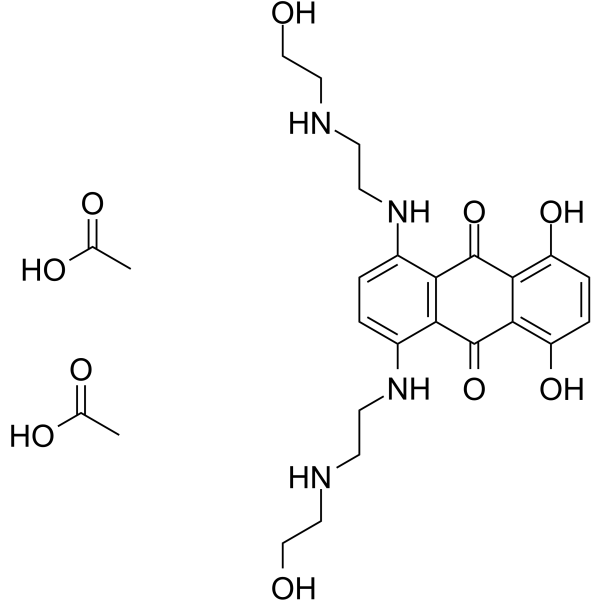70711-41-0
| Name | 9,10-Anthracenedione, 1,4-dihydroxy-5,8-bis[[2- [(2-hydroxyethyl)amino]ethyl]amino]-, diacetate (salt) |
|---|
| Description | Mitoxantrone diacetate is a potent topoisomerase II inhibitor. Mitoxantrone diacetate also inhibits protein kinase C (PKC) activity with an IC50 of 8.5 μM. Mitoxantrone diacetate induces apoptosis of B-CLL (B-chronic lymphocytic leukaemia) cells. Mitoxantrone diacetate shows antitumor activity[1][2][3][4]. Mitoxantrone diacetate also has anti-orthopoxvirus activity with EC50s of 0.25 μM and and 0.8 μM for cowpox and monkeypox, respectively[5]. |
|---|---|
| Related Catalog | |
| Target |
IC50: 8.5 μM (PKC)[1] |
| In Vitro | Mitoxantrone diacetate inhibits PKC in a competitive manner with respect to histone H1, and its Ki value is 6.3 μM and in a non-competitive manner with respect to phosphatidylserine and ATP[1]. Mitoxantrone diacetate (0.5 μg/mL, 48 h) induces a decrease in B-CLL cells. Mitoxantrone diacetate induces DNA fragmentation and the proteolytic cleavage of poly(ADP-ribose) polymerase (PARP), demonstrating that the cytotoxic effect of Mitoxantrone diacetate is due to induction of apoptosis[2]. Mitoxantrone diacetate shows cytotoxicity to human breast carcinoma cell lines MDA-MB-231 and MCF-7 with IC50 values of 18 and 196 nM, respectively[3]. |
| In Vivo | Mitoxantrone diacetate (IP, 0-3.2 mg/kg/day) produces a statistically significant number of 60-day survivors at 1.6 mg/kg in mice with IP implanted L1210 leukemia[4]. Mitoxantrone diacetate (IV, 0-3.2 mg/kg/day) shows effective antitumor activities and produces a 60% ILS (increase in lifespan) at 3.2 mg/kg in SC implanted Lewis lung carcinoma[4]. |
| Density | 1.45g/cm3 |
|---|---|
| Boiling Point | 805.7ºC at 760 mmHg |
| Melting Point | 203-5ºC |
| Molecular Formula | C24H32N4O8 |
| Molecular Weight | 504.53300 |
| Flash Point | 441.1ºC |
| Exact Mass | 504.22200 |
| PSA | 200.48000 |
| LogP | 0.87950 |
CHEMICAL IDENTIFICATION
HEALTH HAZARD DATAACUTE TOXICITY DATA
MUTATION DATA
|
